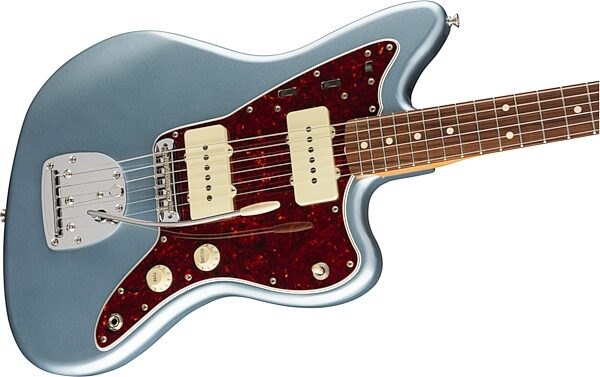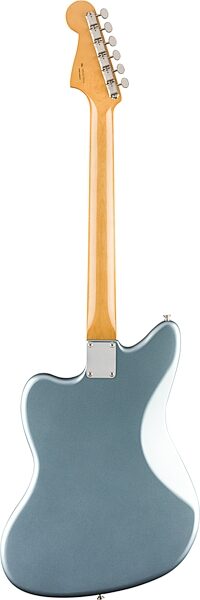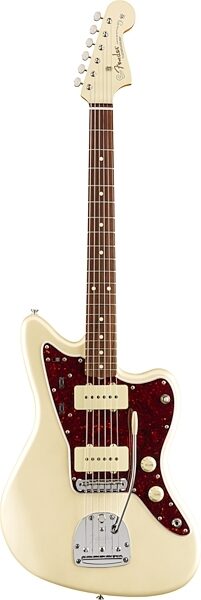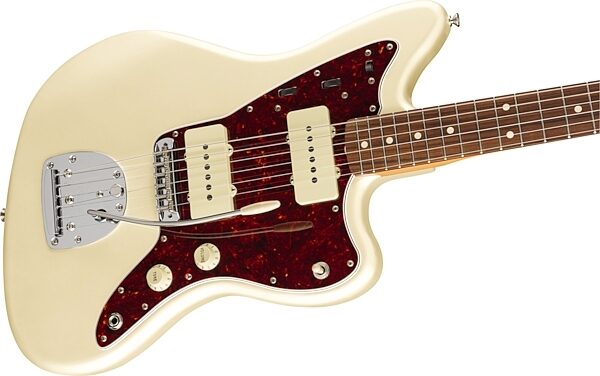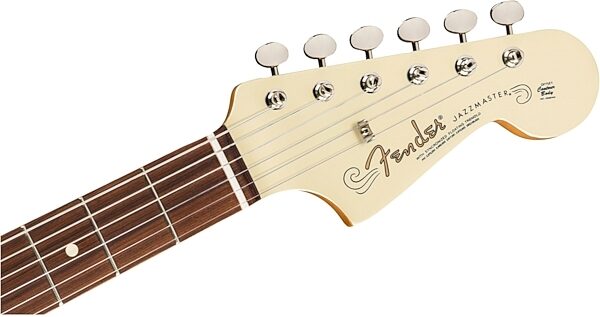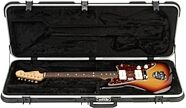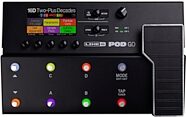Fender Vintera '60s Jazzmaster Electric Guitar, Pau Ferro Fingerboard (with Gig Bag)
No longer available at zZounds



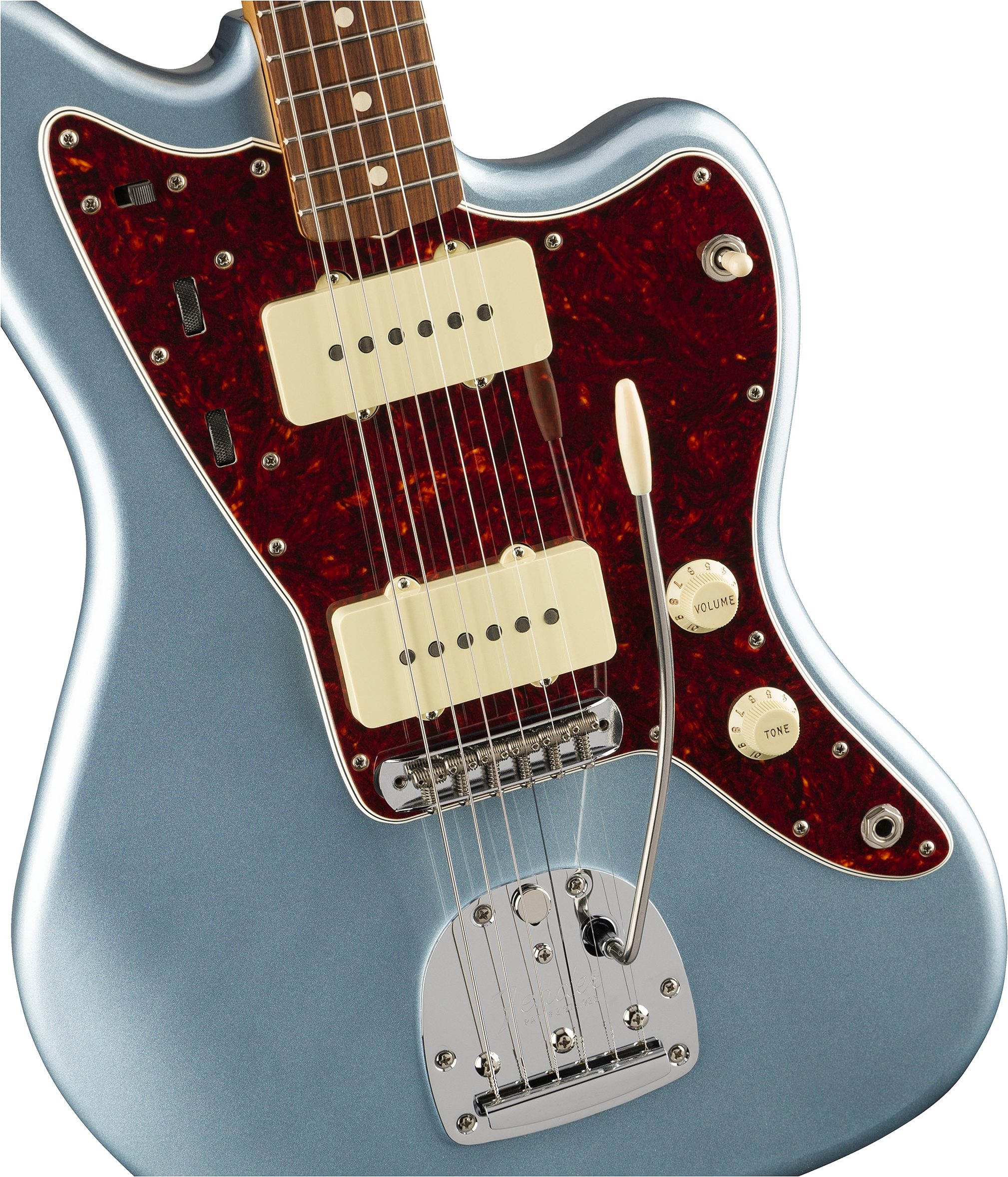



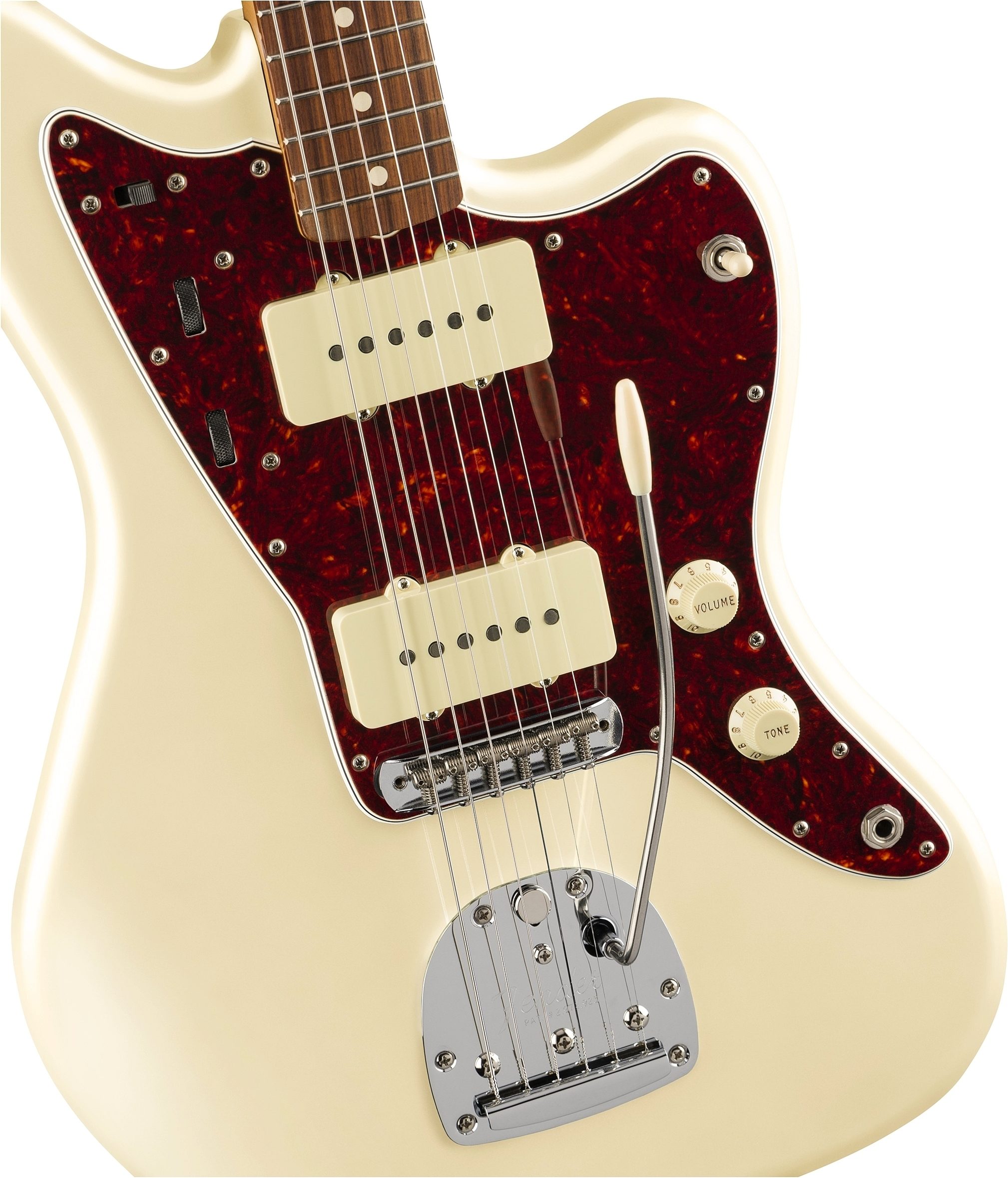



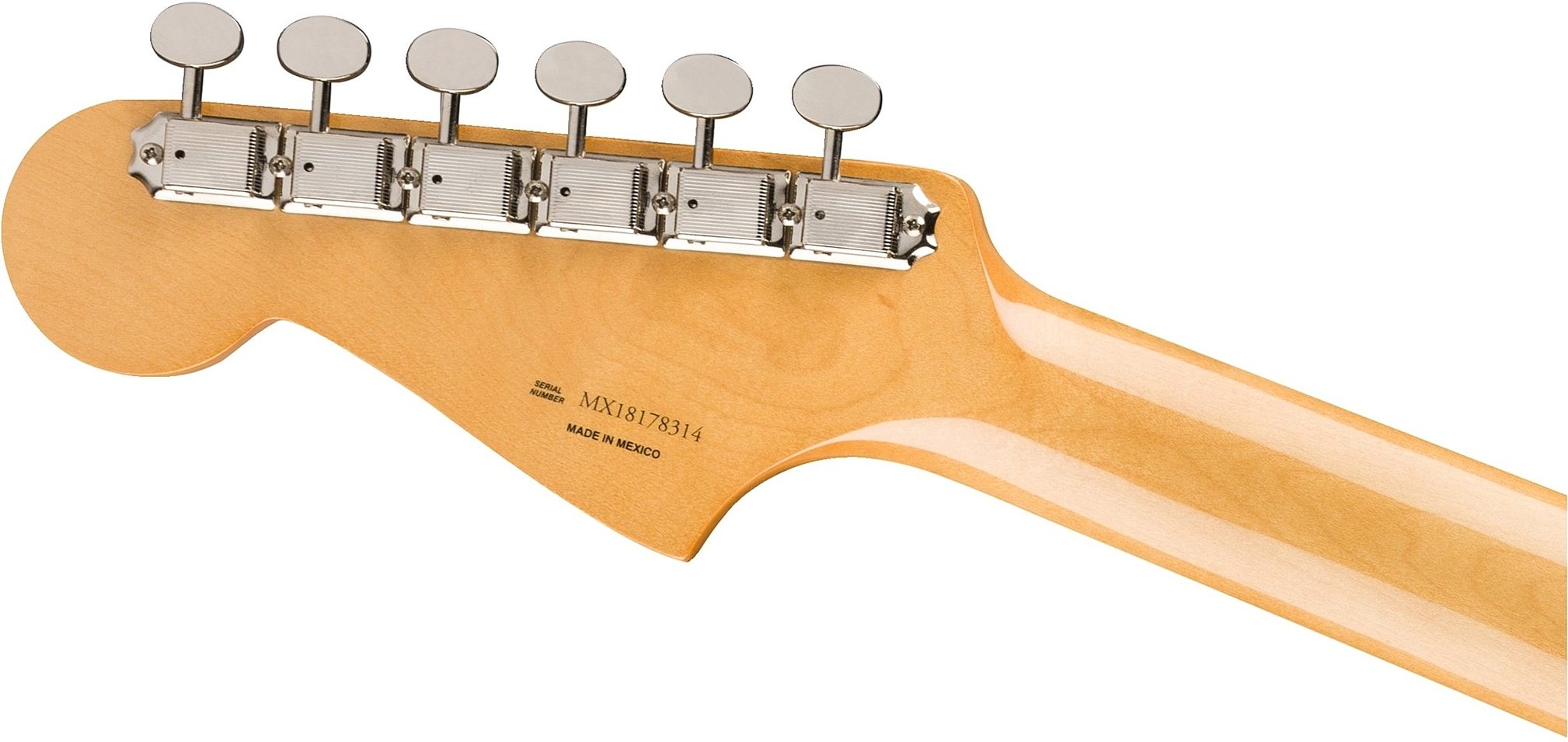
With its sleek offset body and matching headstock, this Vintera Jazzmaster is ready to hang ten in the tone ocean thanks to its re-voiced wide single-coils.
What's special about this item?
| Feature: | What it does: |
|---|---|
| Alder body | Light weight with a wide tonal range |
| Jazzmaster-style floating tremolo tailpiece | Vintage Fender vibrato with locking mechanism |
| Pau Ferro fretboard | Delivers strong midrange presence and punch |
| Vintage-Style '60s Jazzmaster Pickups | Re-voiced to deliver authentic tone |
Overview
For players who want the style and sound of Fender's golden era, Fender created the Vintera '60s Jazzmaster. Equipped with the coveted features that defined the decade - including period-accurate neck profile and playing feel, along with re-voiced pickups - this guitar has all of the warm, smooth sound that made the Jazzmaster a legend.
Learn how to unlock all the tones from a Jazzmaster:
For authentic, vintage-style tone, Fender re-voiced the pair of wide single-coil Jazzmaster pickups to behave more like the originals. The warm, smooth-sounding neck pickup is balanced by the bright, cutting bridge pickup. The "Mid '60s C"-shaped neck has a classy painted headstock, along with a 7.25"-radius maple fingerboard with 21 vintage-style frets for classic feel. A vintage-style Jazzmaster floating tremolo and vintage-style tuning machines provide original-era aesthetics, rock-solid performance and tuning stability. Other features include the classic lead/rhythm circuit, chrome hardware and 4-bolt neck plate. Includes a deluxe gig bag.
Learn how to unlock all the tones from a Jazzmaster:
For authentic, vintage-style tone, Fender re-voiced the pair of wide single-coil Jazzmaster pickups to behave more like the originals. The warm, smooth-sounding neck pickup is balanced by the bright, cutting bridge pickup. The "Mid '60s C"-shaped neck has a classy painted headstock, along with a 7.25"-radius maple fingerboard with 21 vintage-style frets for classic feel. A vintage-style Jazzmaster floating tremolo and vintage-style tuning machines provide original-era aesthetics, rock-solid performance and tuning stability. Other features include the classic lead/rhythm circuit, chrome hardware and 4-bolt neck plate. Includes a deluxe gig bag.
Specs
- Series: Vintera
- Model Name: '60s Jazzmaster
- Color: Ice Blue Metallic
- Body Finish: Gloss Polyester
- Body Material: Alder
- Neck: Maple, Thin "C", Gloss Urethane Finish
- Fingerboard: Pau Ferro
- Fingerboard Radius: 7.25" (184.1 mm)
- Frets: 21 Vintage
- Scale Length: 25.5" (648 mm)
- Nut Width: 1.650" (42 mm)
- Nut Material: Synthetic Bone
- Orientation: Right-Hand
- Position Inlays: White Dots
- Configuration: SS
- Neck Pickup: Vintage-Style '60s Single-Coil Jazzmaster
- Bridge Pickup: Vintage-Style '60s Single-Coil Jazzmaster
- Controls:
- Lead Circuit Controls (Slide Switch Down): Volume (Neck), Volume (Bridge), Master Tone
- Rhythm Circuit Controls (Slide Switch Up): Two Thumbwheel Controls for Neck Pickup Volume and Tone
- Control Knobs: Aged White
- Pickguard: 4-Ply Tortoiseshell
- Bridge: 6-Saddle Vintage-Style Adjustable with "Floating" Tremolo Tailpiece
- Tuning Machines: Vintage-Style
- Hardware Finish: Nickel/Chrome
- Strings: Fender USA 250L, NPS, (.009-.042 Gauges)
- Case/Gig Bag: Deluxe Gig Bag
- Model Name: '60s Jazzmaster
- Color: Ice Blue Metallic
- Body Finish: Gloss Polyester
- Body Material: Alder
- Neck: Maple, Thin "C", Gloss Urethane Finish
- Fingerboard: Pau Ferro
- Fingerboard Radius: 7.25" (184.1 mm)
- Frets: 21 Vintage
- Scale Length: 25.5" (648 mm)
- Nut Width: 1.650" (42 mm)
- Nut Material: Synthetic Bone
- Orientation: Right-Hand
- Position Inlays: White Dots
- Configuration: SS
- Neck Pickup: Vintage-Style '60s Single-Coil Jazzmaster
- Bridge Pickup: Vintage-Style '60s Single-Coil Jazzmaster
- Controls:
- Lead Circuit Controls (Slide Switch Down): Volume (Neck), Volume (Bridge), Master Tone
- Rhythm Circuit Controls (Slide Switch Up): Two Thumbwheel Controls for Neck Pickup Volume and Tone
- Control Knobs: Aged White
- Pickguard: 4-Ply Tortoiseshell
- Bridge: 6-Saddle Vintage-Style Adjustable with "Floating" Tremolo Tailpiece
- Tuning Machines: Vintage-Style
- Hardware Finish: Nickel/Chrome
- Strings: Fender USA 250L, NPS, (.009-.042 Gauges)
- Case/Gig Bag: Deluxe Gig Bag
Reviews
Reviewers gave this product an overall rating of 4.5 out of 5 stars.
(4 ratings)
Submitted November 20, 2021 by a customer from gmail.com
"Jazzmasters can be excellent, but not for everyone."
This review has been selected by our experts as particularly helpful.
I got my ice blue metallic vintera 60s jazzmaster in October 2019, back when virtually no one had them for sale. I'm going to be brutally honest here, I'm not going to gloss over anything, this ain't no honeymoon period influenced review. If you're new to jazzmasters the guitar is quite big and heavy, they usually weigh 8 pounds or more, you'll probably get confused by having 2 switches and 2 sets of pots at first. The bridge and neck is moved further up than a strat or tele, so the guitar feels like a much longer scale, but nope it's 25.5".The biggest problem for people new to the jazzmaster is a lack of knowledge on how to set them up properly, so they operate as intended. I've seen so many people get a jazzmaster, and use 9s on them and have all sorts of problems, then go down a rabbit hole of buying fixes when all that was needed was thicker strings.When the jazzmaster was designed, the lightest strings you could get was 12's with a wound g. Just a few years before, all strings were flatwound.Leo fender and others working on the jazzmaster decided on a very low break angle over the bridge. It worked just fine back then. None of the commonly reported issues you can find on the internet. These problems came around in the late 60s when 10's, 9's, and 8's started being made. People put them on the jazzmaster, and people blamed the guitar, when it was just user error, and the general guitar playing public not knowing simple physics. Heavier strings have more tension, more tension…
read more
puts more downward pressure on the saddles and bridge, the bridge becomes stable, strings don't pop out of the saddle grooves, and it all works. I'm not saying 12's with a wound g is necessary, but 11's are a very good idea. It won't hurt you to build up a little finger strength. As for the actual review, I'll do that in the detailed review section.
Sound
Today's guitars are all made on cnc's unless you get something like a US made G&L, those are cut out with bandsaws and routers, like fenders in the 50s up to the 70s. The neck pocket in mine is very clean and neat, the body routing is very clean, the frets were nice out of the box, no misaligned screws or parts, no blemishes in the finish or anything.
Features
The least useful feature for a majority of people will be the rhythm circuit, it has its own volume and tone pots and is neck pickup only, with a much darker tone than the neck pickup on the lead circuit, leave the switch in the down position, and you never have to worry about it unless you want an old school jazz guitar tone. Then push that switch up. (It does old jazz guitar really well)
Ease of Use
The jazzmaster has quite a bright bridge pickup, makes it well suited for surf, or spaghetti western guitar, but it also means distortion on the bridge pickup will cut through rather well. the neck pickup is strat like, but bigger and thicker. Like a strat neck pickup on steroids. Both pickups together results in a sweet soft sort of quack tone, due to the pickups being so far apart, it's not the same as a strat quack tone, but its very nice sounding. Then of course there's the neck only rhythm circuit which is very much like an old jazz tone (hence the name Jazzmaster)The pickups are generally higher output than most other fender pickups, and work well with distortion. A lot of people still think jazzmaster pickups are p90s. Nope, real jazzmaster pickups are roughly the same size, but thats where the similarities end. They don't even sound similar. This confusion is furthered by the old mexican player jazzmasters, the j mascius, and others that have P90's.
Quality
Fender mexico didn't skimp on the electronic parts, the pickups are very much like a mid 60s jazzmaster in sound, even down to the gray bobbins and enamel coated coil wire. Pots are CTS, both switches and the jack are switchcraft, just like they are supposed to be. They should last forever. The trem is built well, but not exactly the same as the old ones, the trem arm is screw in, it really should be a push in arm, like all the old ones. Also, I think the hole of the trem arm in the top plate is way way too big, it only needs to be slightly bigger than the trem arm collet.The tuners are kluson like split shaft, loke fender used from the very earliest days until 68, they're not made by kluson but it doesn't matter the design is too simple to screw up. The frets are vintage, they're always described as tall and thin. They're not tall, but they are thin, it is a 60s styled guitar after all. But I think a lot of people used to 9.5 and flatter radiuses will have problems, it's a 7.25" radius fretboard, requires a bit higher action but a half hour or so of playing, you get used to it. It also has a truss rod nut at the heel of the neck, its a correct feature for all fender's prior to 1971, but man was that a bad design choice on leo fender's part. You either have to loosen the neck a lot or take it completely off to adjust neck relief, and hope you got it right.Now when I got my guitar I took it completely apart (I always do). What I found on the inside could be improved. First was an excessive amount of wire. There is a lot of wire in a jazzmaster, but they didn't even bother cutting the pickup leads to length. Both pickups had about a foot of unnecessary lead wire, so I fixed that.The other issue was a bad conductive paint job in the cavities. The jazzmaster is an electrically noisy guitar, they need all the shielding they can get. The conductive paint was one thin coat, and didn't even go up the sides of the cavities, it wasn't doing anything. From 1958 to the end of the original run around 1980 each jazzmaster had brass tubs in all the cavities, all soldered together and grounded. I don't expect that in a new jazzmaster, but they knew then that it needed shielding. The pickguard in 58 was also gold anodized aluminum, which was excellent for shielding. But the anodizing wasn't good, and the gold wore off after a few months so and looked awful. In 59 fender switched to plastic tort pickguards, with a thin pickguard sized aluminum shield underneath. Anyway I properly shielded the cavities. Also the pickguard only had aluminum tape for the toggle switch to the jack, and another piece for piece for rhythm circuit switch and pots. That ain't going to do it. I added more shielding, put it all back together and it was a major improvement. Recently I decided to see what a proper gold anodized aluminum pickguard would look like on ice blue metallic, and its VERY cool, looks like a 1960s california speed shop modded my guitar, might put some tele knobs on it sometime.I also made another modification, I had a 65 reissue trem and bridge laying around, so I put them on it. In the old days, the lock button, trem arm collet, and the channel that the saddles sit in on the bridge wasn't a shiny chrome finish, they looked more a frosted chrome or stainless steel. The 65 reissue parts have that same look, the trem also has a better feel.Some people tend to bash on pao ferro, without having any experience with it. Those people are dumb. There's nothing wrong with pao ferro, it isn't plain chocolate brown like rosewood, you'll get everything from tan to black streaks in it and lots of red, I think it's a nice looking wood, and can be darkened up nicely just by oiling it. feels the same as rosewood to me, some will tell you it sounds wildly different, I highly doubt it, the same sorts of people still believe nitro paint makes a guitar sound different and better, and fail to realize a lot of fender old nitro paints were acrylic, and the guitar is covered in a plastic based sealer before painting.
Value
A lot of people will see the price tag of a vintera jazzmaster then see its made in Mexico, and say it's way overpriced. It's a quality guitar, with quality parts, just needs better shielding and some tidying up under the hood. Also, I keep in mind the fact that in the mid 60s a jazzmaster cost 345 bucks. Sounds super cheap. In today's money that's over $3,000. Today's guitars are far more consistent, and actually far more affordable. When I was growing up, everyone wanted a fender. Most of us ended up with Teisco, or a silvertone, a kay, an airline or a danolectro if we were lucky, and all those guitars were dreadful. Today almost anyone can afford a high quality fender.
Manufacturer Support
I've never needed to call fender, but everything I've heard from people who called fender was good.
The Wow Factor
The appeal of the jazzmaster is quite high, 20 years ago you couldn't give them away, now they're everywhere. It was a crazy radical guitar from the late 50s, the top horn even sort of resembles the jet age fins that were on every car. But I can't say I'd recommend a jazzmaster to someone that has no experience with a properly set up proper old school jazzmaster. That's why I rated that as a 6 out of 10, but I can't stop anyone from getting one. If you're new to them, Read up on everything about them, especially set up guides. Follow those set up guides, and it'll be awesome.
read less
Sound
Today's guitars are all made on cnc's unless you get something like a US made G&L, those are cut out with bandsaws and routers, like fenders in the 50s up to the 70s. The neck pocket in mine is very clean and neat, the body routing is very clean, the frets were nice out of the box, no misaligned screws or parts, no blemishes in the finish or anything.
Features
The least useful feature for a majority of people will be the rhythm circuit, it has its own volume and tone pots and is neck pickup only, with a much darker tone than the neck pickup on the lead circuit, leave the switch in the down position, and you never have to worry about it unless you want an old school jazz guitar tone. Then push that switch up. (It does old jazz guitar really well)
Ease of Use
The jazzmaster has quite a bright bridge pickup, makes it well suited for surf, or spaghetti western guitar, but it also means distortion on the bridge pickup will cut through rather well. the neck pickup is strat like, but bigger and thicker. Like a strat neck pickup on steroids. Both pickups together results in a sweet soft sort of quack tone, due to the pickups being so far apart, it's not the same as a strat quack tone, but its very nice sounding. Then of course there's the neck only rhythm circuit which is very much like an old jazz tone (hence the name Jazzmaster)The pickups are generally higher output than most other fender pickups, and work well with distortion. A lot of people still think jazzmaster pickups are p90s. Nope, real jazzmaster pickups are roughly the same size, but thats where the similarities end. They don't even sound similar. This confusion is furthered by the old mexican player jazzmasters, the j mascius, and others that have P90's.
Quality
Fender mexico didn't skimp on the electronic parts, the pickups are very much like a mid 60s jazzmaster in sound, even down to the gray bobbins and enamel coated coil wire. Pots are CTS, both switches and the jack are switchcraft, just like they are supposed to be. They should last forever. The trem is built well, but not exactly the same as the old ones, the trem arm is screw in, it really should be a push in arm, like all the old ones. Also, I think the hole of the trem arm in the top plate is way way too big, it only needs to be slightly bigger than the trem arm collet.The tuners are kluson like split shaft, loke fender used from the very earliest days until 68, they're not made by kluson but it doesn't matter the design is too simple to screw up. The frets are vintage, they're always described as tall and thin. They're not tall, but they are thin, it is a 60s styled guitar after all. But I think a lot of people used to 9.5 and flatter radiuses will have problems, it's a 7.25" radius fretboard, requires a bit higher action but a half hour or so of playing, you get used to it. It also has a truss rod nut at the heel of the neck, its a correct feature for all fender's prior to 1971, but man was that a bad design choice on leo fender's part. You either have to loosen the neck a lot or take it completely off to adjust neck relief, and hope you got it right.Now when I got my guitar I took it completely apart (I always do). What I found on the inside could be improved. First was an excessive amount of wire. There is a lot of wire in a jazzmaster, but they didn't even bother cutting the pickup leads to length. Both pickups had about a foot of unnecessary lead wire, so I fixed that.The other issue was a bad conductive paint job in the cavities. The jazzmaster is an electrically noisy guitar, they need all the shielding they can get. The conductive paint was one thin coat, and didn't even go up the sides of the cavities, it wasn't doing anything. From 1958 to the end of the original run around 1980 each jazzmaster had brass tubs in all the cavities, all soldered together and grounded. I don't expect that in a new jazzmaster, but they knew then that it needed shielding. The pickguard in 58 was also gold anodized aluminum, which was excellent for shielding. But the anodizing wasn't good, and the gold wore off after a few months so and looked awful. In 59 fender switched to plastic tort pickguards, with a thin pickguard sized aluminum shield underneath. Anyway I properly shielded the cavities. Also the pickguard only had aluminum tape for the toggle switch to the jack, and another piece for piece for rhythm circuit switch and pots. That ain't going to do it. I added more shielding, put it all back together and it was a major improvement. Recently I decided to see what a proper gold anodized aluminum pickguard would look like on ice blue metallic, and its VERY cool, looks like a 1960s california speed shop modded my guitar, might put some tele knobs on it sometime.I also made another modification, I had a 65 reissue trem and bridge laying around, so I put them on it. In the old days, the lock button, trem arm collet, and the channel that the saddles sit in on the bridge wasn't a shiny chrome finish, they looked more a frosted chrome or stainless steel. The 65 reissue parts have that same look, the trem also has a better feel.Some people tend to bash on pao ferro, without having any experience with it. Those people are dumb. There's nothing wrong with pao ferro, it isn't plain chocolate brown like rosewood, you'll get everything from tan to black streaks in it and lots of red, I think it's a nice looking wood, and can be darkened up nicely just by oiling it. feels the same as rosewood to me, some will tell you it sounds wildly different, I highly doubt it, the same sorts of people still believe nitro paint makes a guitar sound different and better, and fail to realize a lot of fender old nitro paints were acrylic, and the guitar is covered in a plastic based sealer before painting.
Value
A lot of people will see the price tag of a vintera jazzmaster then see its made in Mexico, and say it's way overpriced. It's a quality guitar, with quality parts, just needs better shielding and some tidying up under the hood. Also, I keep in mind the fact that in the mid 60s a jazzmaster cost 345 bucks. Sounds super cheap. In today's money that's over $3,000. Today's guitars are far more consistent, and actually far more affordable. When I was growing up, everyone wanted a fender. Most of us ended up with Teisco, or a silvertone, a kay, an airline or a danolectro if we were lucky, and all those guitars were dreadful. Today almost anyone can afford a high quality fender.
Manufacturer Support
I've never needed to call fender, but everything I've heard from people who called fender was good.
The Wow Factor
The appeal of the jazzmaster is quite high, 20 years ago you couldn't give them away, now they're everywhere. It was a crazy radical guitar from the late 50s, the top horn even sort of resembles the jet age fins that were on every car. But I can't say I'd recommend a jazzmaster to someone that has no experience with a properly set up proper old school jazzmaster. That's why I rated that as a 6 out of 10, but I can't stop anyone from getting one. If you're new to them, Read up on everything about them, especially set up guides. Follow those set up guides, and it'll be awesome.
read less
61 of 61 people (100%) people found this review helpful. Did you?
Thanks for your opinion!
No longer available at zZounds
In most cases, a product is unavailable because it has been discontinued by the manufacturer
This is a carousel with product cards. Use the previous and next buttons to navigate.
Cases and Bags
This is a carousel with product cards. Use the previous and next buttons to navigate.
Cases and Bags
This is a carousel with product cards. Use the previous and next buttons to navigate.

